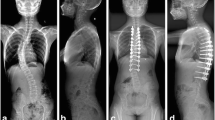Abstract
Introduction
Comparisons of all-pedicle-screw (PS) and hybrid hook-screw (HS) instrumentation for the treatment of adolescent idiopathic scoliosis (AIS) have produced conflicting results. The aim of this study was to compare all-pedicle-screw and hybrid hook-screw instrumentation for the treatment of AIS using a matched-pair study design in which preoperative flexibility was matched.
Methods
In this retrospective study conducted at one medical center, 21 all-pedicle-screw/hybrid hook-screw pairs of Lenke type I AIS patients matched for age, height, weight, body mass index, sex, and preoperative curve flexibility who had been treated at our institution from January 2000 to October 2006 were selected. Postoperative and 2-year postoperative coronal curve correction, postoperative kyphosis, blood transfusion needs, operation time, and hospital cost were measured and analyzed statistically.
Results
The PS group compared with the HS group had better postoperative correction (P = 0.0231) and 2-year coronal curve correction (P = 0.016). While statistically significant (P = 0.0073), the postoperative Cobb angle was only 3° less in the PS group, Maintenance of correction after 2 years was better in the PS group (P = 0.0016). The PS group had less blood loss (P < 0.0001) and shorter operation time (P < 0.0001), but the hospital cost for the PS group was higher (P < 0.0001).
Conclusions
All-pedicle-screw and hybrid hook-screw instrumentations are comparable with regard to curve correction, but all-pedicle screw instrumentation reduces blood loss during surgery and shortens the operation time, which may help shorten healing time.
Similar content being viewed by others
References
Kim HJ, Blanco JS, Widmann RF (2009) Update on the management of idiopathic scoliosis. Curr Opin Pediatr 21(1):55–64
Kim YJ, Lenke LG, Kim J et al (2006) Comparative analysis of pedicle screw versus hybrid instrumentation in posterior spinal fusion of adolescent idiopathic scoliosis. Spine 31(3):291–298
Hicks JM, Singla A, Shen FH, Arlet V (2010) Complications of pedicle screw fixation in scoliosis surgery. A systematic review. Spine 35(11):E465–E470
Barr SJ, Schuette AM, Emans JB (1997) Lumbar pedicle screws versus hooks. Results in double major curves in adolescent idiopathic scoliosis. Spine 22(12):1369–1379
Dobbs MB, Lenke LG, Kim YJ, Kamath G, Peelle MW, Birdwell KH (2006) Selective posterior thoracic fusions for adolescent idiopathic scoliosis: comparison of hooks versus pedicle screws. Spine 31(20):2400–2404
Cheng I, Kim Y, Gupta MC et al (2005) Apical sublaminar wires versus pedicle screws—which provides better results for surgical correction of adolescent idiopathic scoliosis? Spine 30(18):2104–2112
Lowenstein JE, Matsumoto H, Vitale MG et al (2007) Coronal and sagittal plane correction in adolescent idiopathic scoliosis: a comparison between all pedicle screw versus hybrid thoracic hook lumbar screw constructs. Spine 32(4):448–452
Storer SK, Vitale MG, Hyman JE, Lee FY, Choe JC, Roye DP Jr (2005) Correction of adolescent idiopathic scoliosis using thoracic pedicle screw fixation versus hook constructs. J Pediatr Orthop 25(4):415–419
Wu X, Yang S, Xu W et al (2005) Comparative intermediate and long-term results of pedicle screw and hook instrumentation in posterior correction and fusion of idiopathic thoracic scoliosis. J Pediatr Orthop 25(4):415–419
Karatoprak O, Unay K, Tezer M, Ozturk C, Aydogan M, Mirzanli C (2008) Comparative analysis of pedicle screw versus hybrid instrumentation in adolescent idiopathic scoliosis surgery. Int Orthop 32(4):523–528
Cheung KM (2008) Comment on Karatoprak et al. Comparative analysis of pedicle screw versus hybrid instrumentation in adolescent idiopathic scoliosis surgery. Int Orthop 32(4):529
Vora V, Crawford A, Babekhir N et al (2007) A pedicle screw construct gives an enhanced posterior correction of adolescent idiopathic scoliosis when compared with other constructs. Myth or reality. Spine 32(17):1869–1874
Cuartas E, Rasouli A, O’Brien M, Shufflebarger HL (2009) Use of all-pedicle-screw constructs in the treatment of adolescent idiopathic scoliosis. J Am Acad Orthop Surg 17(9):550–561
Helgeson MD, Shah SA, Newton PO et al (2010) Evaluation of proximal junctional kyphosis in adolescent idiopathic scoliosis following pedicle screw, hook, or hybrid instrumentation. Spine 35(2):177–181
Conflict of interest
None of the authors had a conflict of interest.
Author information
Authors and Affiliations
Corresponding author
Additional information
C. Yang and X. Wei are co-first authors.
Rights and permissions
About this article
Cite this article
Yang, C., Wei, X., Zhang, J. et al. All-pedicle-screw versus hybrid hook-screw instrumentation for posterior spinal correction surgery in adolescent idiopathic scoliosis: a curve flexibility matched-pair study. Arch Orthop Trauma Surg 132, 633–639 (2012). https://doi.org/10.1007/s00402-011-1454-7
Received:
Published:
Issue Date:
DOI: https://doi.org/10.1007/s00402-011-1454-7



